2 DOORS EARLY RENAISSANCE
ca. 1520
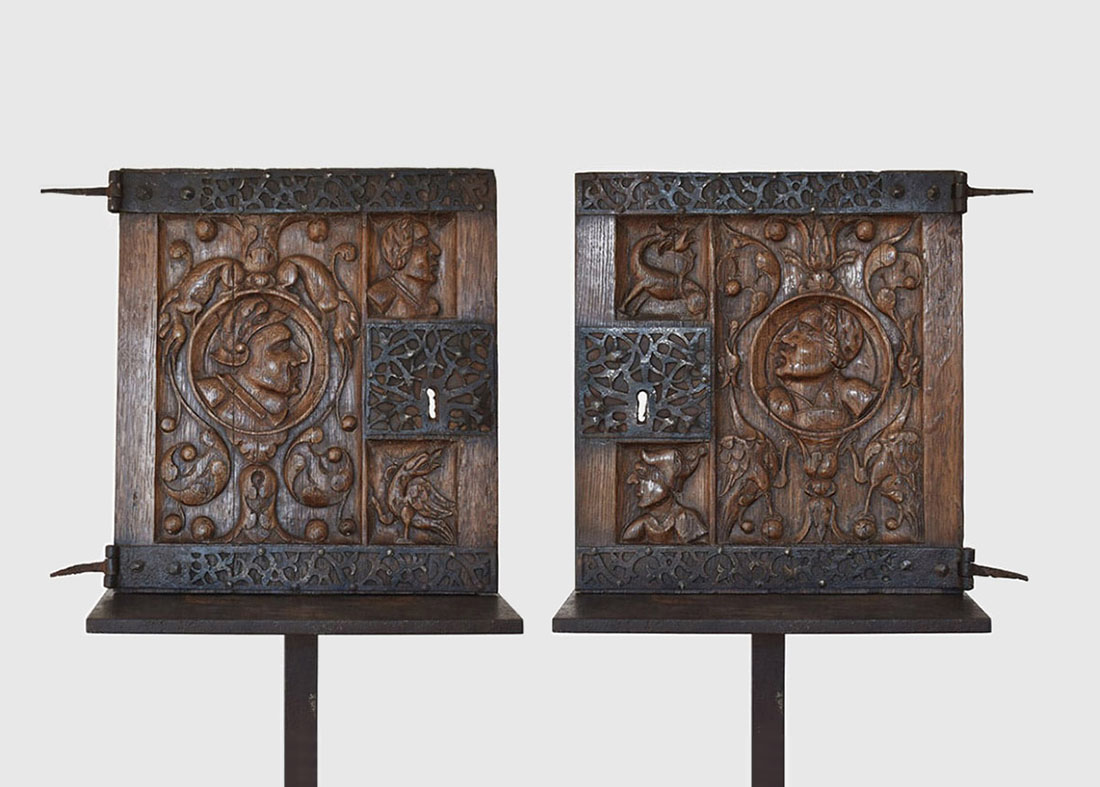
Transitional style
In the late fifteenth century new motifs inspired by Roman antiquity were introduced in northwest Europe. Examples of which can be found on panels and doors of Late Gothic furniture from the early sixteenth century.
Whereas the way of construction and metalwork used still adhere to the Late Gothic tradition, the doors show Early Renaissance carvings of heads in profile in medallions, so-called Romayne Heads. The woman with fashionable headdress, the man helmed as a soldier.
The shift from one period to another brings about a transitional style of its own. But as Gothic and Renaissance seems almost opposites, the question is raised where these new concepts came from and how they go together.
Renaissance, the new intellectual movement, originated in Italy.
During excavations in Rome in 1480, the Villa of emperor Nero was found. On the walls of this Domus Aurea or Golden House, Italian as well as Netherlandish painters could see with their own eyes the untouched frescos and decorations from ca. 68 AD. Among those were portret medallions.
The ornamentations were called Grottesque deriving from the Italian word Grotte, meaning cave, referring to their underground situation.
Depicted in books and prints these novelties quickly spread across Europe, introducing new forms and ideas to furniture makers. When commissioning an artwork one now had a choice between the flamboyant, Late Gothic ‘modern’ style or the Early Renaissance ‘antique’ Roman style.
Around the year 1500, architects and furniture makers where able to work in both styles or or a mix of the two – a transition style- as can be seen in Late Gothic altar retables adorned with Early Renaissance sculptures.
For us, 500 years later, it is not always easy to understand just what we are looking at.
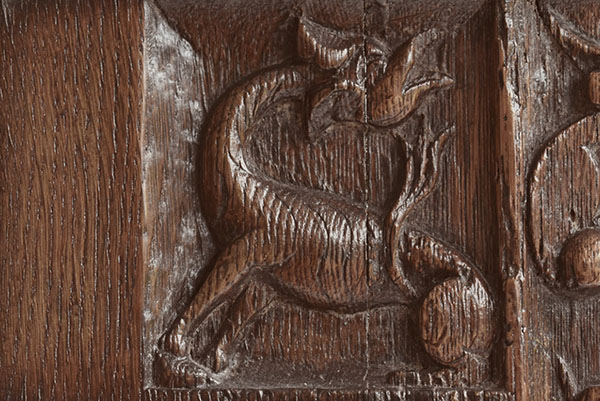
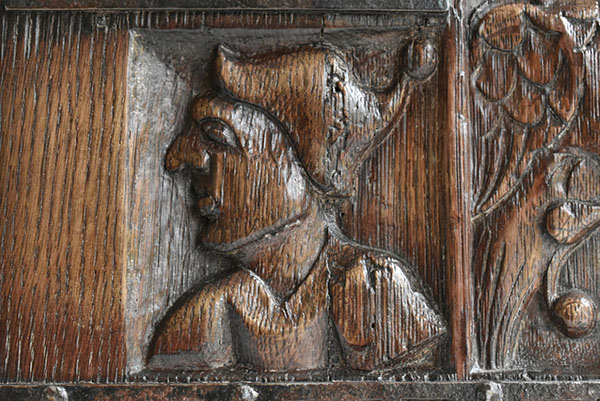
Fontainebleau
The renaissance was introduced to France during the fifteenth and early sixteenth century by Italian artists who were invited by Francois I in 1530 to decorate his chateau of Fontainebleau.
The confident gentry and powerful haute bourgeoisie of northwest Europe embraced the new ‘antique’ style to express their increased standing. Margaretha of Austria, Governess of the Low Countries, had her sepulchre church and tomb built between 1510-1530 in Brou (Bourg-en-Bresse).
The building scheme and speed of construction showed her power and wealth.
While at first she wanted her monuments ‘inspired by things in antique style’, later on she decided on the virtuoso of Late Gothic.
Gothic remained the style of choice for buildings reflecting ecclesiastical power or that of secular authority, while building costs for Gothic were much higher than for a Renaissance building.
The doors are carved in this new style, though not yet symmetrical in design. With separated right-angled fields, the arrangement is still late gothic.
The main field with a candelabra-like centre axis of leaves, in the middle the medallion and head in profile, surrounded by curly leaves and fantasy creatures. To the side are smaller fields with carvings of people and animals. Themes are not repeated anywhere and even down to detail level the diversity is remarkable.
The man and woman in the medallions face each other when the doors are closed. Resting on top of the medallion with the man are two half-dog, half- bird fantasy creatures, whereas the portrait of the woman is held up by a pair of cranes. On the left side of the woman, in two smaller fields, are a man and a dragon. To the right of the man a bird and a woman can be seen.
The doors are embellished with pierced, wrought iron hinges and lock plates, with motifs of plants and leaves, like the ornamented borders of medieval illuminated books. This type of ironwork was often tinned to protect it from oxidation through acids in the oak (which cause dark stains around the metal). Originally it would have been silvery in appearance, but in the course of 500 years it has darkened considerably.
For more striking effect, a coloured piece of fabric was often added behind the metalwork; through the open parts a blue or red velvet could be seen.

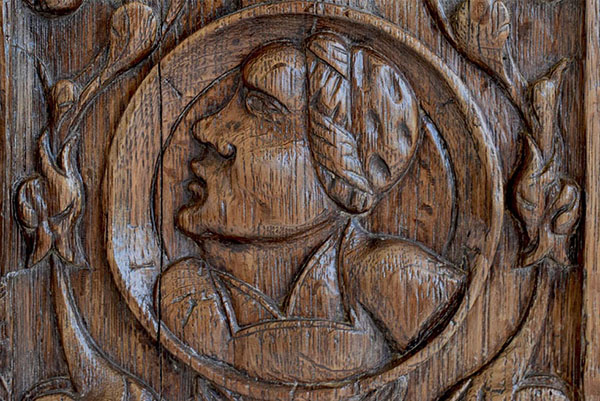
Technique and Dressoir
Oak is vulnerable to shrinkage or warping, caused by changes in humidity. This can lead to cracks. Usage of a single board would have been too much risk for doors of this type, constructed without a frame to hold the panels. Although these small doors appear to have been made from a single piece of oak, in fact they consist of four pieces quarter sawn oak glued together. The iron hinges connecting them provide additional support.
The dressoir of which these doors once were the most important parts, was of typical Late Gothic construction: basically a chest with doors in the front, raised on tall feet, connected at the bottom by boards forming a floor. It was not so much a cupboard for storage, but rather a status symbol and conversation piece for a humanistically educated elite.
Literature
Renaissance Gothic 1470-1540, Ethan Matt Kavaler, YALE University Press 2012.
Le Mobilier Français du Moyen Age a la Renaissance, Jaqueline Boccador, Edition d’Art Monelle Hayot 1988.
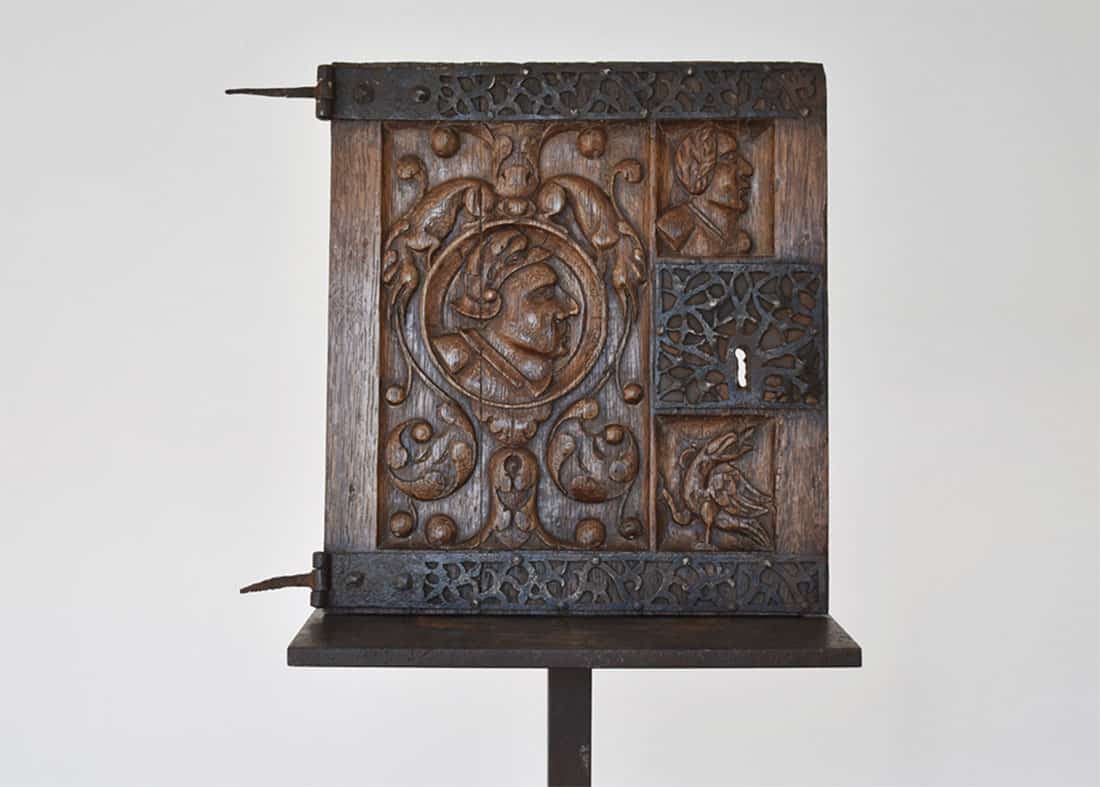

2 DOORS EARLY RENAISSANCE
- Transition period from Late Gothic to Early Renaissance
- ca. 1520
- Northern France or Southern Netherlands
- 33.7 cm x 37.5 cm x 2.2 cm
- 34.2 cm x 37.5 cm x 2.2 cm